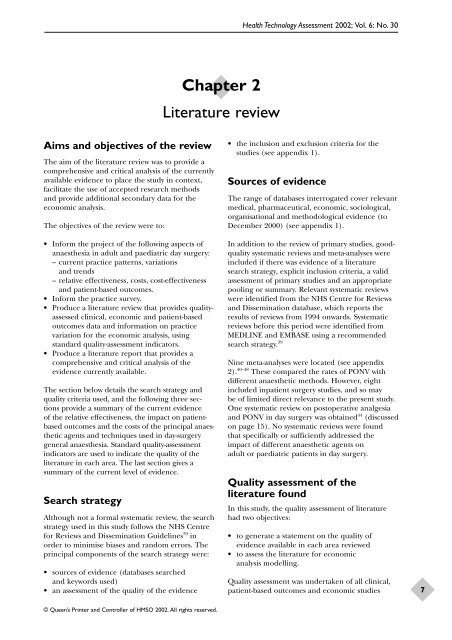Aanesthetic Agents for Day Surgery - NIHR Health Technology ...
Aanesthetic Agents for Day Surgery - NIHR Health Technology ...
Aanesthetic Agents for Day Surgery - NIHR Health Technology ...
You also want an ePaper? Increase the reach of your titles
YUMPU automatically turns print PDFs into web optimized ePapers that Google loves.
Aims and objectives of the review<br />
The aim of the literature review was to provide a<br />
comprehensive and critical analysis of the currently<br />
available evidence to place the study in context,<br />
facilitate the use of accepted research methods<br />
and provide additional secondary data <strong>for</strong> the<br />
economic analysis.<br />
The objectives of the review were to:<br />
• In<strong>for</strong>m the project of the following aspects of<br />
anaesthesia in adult and paediatric day surgery:<br />
– current practice patterns, variations<br />
and trends<br />
– relative effectiveness, costs, cost-effectiveness<br />
and patient-based outcomes.<br />
• In<strong>for</strong>m the practice survey.<br />
• Produce a literature review that provides qualityassessed<br />
clinical, economic and patient-based<br />
outcomes data and in<strong>for</strong>mation on practice<br />
variation <strong>for</strong> the economic analysis, using<br />
standard quality-assessment indicators.<br />
• Produce a literature report that provides a<br />
comprehensive and critical analysis of the<br />
evidence currently available.<br />
The section below details the search strategy and<br />
quality criteria used, and the following three sections<br />
provide a summary of the current evidence<br />
of the relative effectiveness, the impact on patientbased<br />
outcomes and the costs of the principal anaesthetic<br />
agents and techniques used in day-surgery<br />
general anaesthesia. Standard quality-assessment<br />
indicators are used to indicate the quality of the<br />
literature in each area. The last section gives a<br />
summary of the current level of evidence.<br />
Search strategy<br />
Although not a <strong>for</strong>mal systematic review, the search<br />
strategy used in this study follows the NHS Centre<br />
<strong>for</strong> Reviews and Dissemination Guidelines 39 in<br />
order to minimise biases and random errors. The<br />
principal components of the search strategy were:<br />
• sources of evidence (databases searched<br />
and keywords used)<br />
• an assessment of the quality of the evidence<br />
© Queen’s Printer and Controller of HMSO 2002. All rights reserved.<br />
Chapter 2<br />
Literature review<br />
<strong>Health</strong> <strong>Technology</strong> Assessment 2002; Vol. 6: No. 30<br />
• the inclusion and exclusion criteria <strong>for</strong> the<br />
studies (see appendix 1).<br />
Sources of evidence<br />
The range of databases interrogated cover relevant<br />
medical, pharmaceutical, economic, sociological,<br />
organisational and methodological evidence (to<br />
December 2000) (see appendix 1).<br />
In addition to the review of primary studies, goodquality<br />
systematic reviews and meta-analyses were<br />
included if there was evidence of a literature<br />
search strategy, explicit inclusion criteria, a valid<br />
assessment of primary studies and an appropriate<br />
pooling or summary. Relevant systematic reviews<br />
were identified from the NHS Centre <strong>for</strong> Reviews<br />
and Dissemination database, which reports the<br />
results of reviews from 1994 onwards. Systematic<br />
reviews be<strong>for</strong>e this period were identified from<br />
MEDLINE and EMBASE using a recommended<br />
search strategy. 39<br />
Nine meta-analyses were located (see appendix<br />
2). 40–48 These compared the rates of PONV with<br />
different anaesthetic methods. However, eight<br />
included inpatient surgery studies, and so may<br />
be of limited direct relevance to the present study.<br />
One systematic review on postoperative analgesia<br />
and PONV in day surgery was obtained 44 (discussed<br />
on page 15). No systematic reviews were found<br />
that specifically or sufficiently addressed the<br />
impact of different anaesthetic agents on<br />
adult or paediatric patients in day surgery.<br />
Quality assessment of the<br />
literature found<br />
In this study, the quality assessment of literature<br />
had two objectives:<br />
• to generate a statement on the quality of<br />
evidence available in each area reviewed<br />
• to assess the literature <strong>for</strong> economic<br />
analysis modelling.<br />
Quality assessment was undertaken of all clinical,<br />
patient-based outcomes and economic studies<br />
7
















